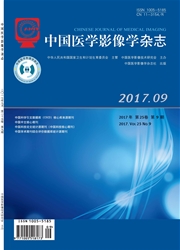

 中文摘要:
中文摘要:
目的运用扩散张量成像(DTI)技术检测创伤后应激障碍(PTSD)患者脑结构完整性的变化及其与临床症状间的关系。资料与方法10例交通伤后应激障碍患者和10例无应激障碍的交通事故亲历者进行DTI扫描,应用基于体素的分析方法比较两组受试者的部分各向异性分数(FA)值和平均扩散系数(MD),并分析有差异脑区的FA值和MD值与创伤后应激障碍自评量表(PCL—C)评分之间的相关性。结果与无应激障碍者比较,PTSD患者双侧额中回、右侧额上回及左侧壳核FA值显著降低(P〈0.01),双侧额中回、前扣带回及左侧杏仁核、脑岛、苍白球的MD值显著增高(P〈0.01)。PTSD患者右侧额中回FA值与PCL—C评分无明显相关性(r=-0.628,P〉0.05),但呈负相关趋势:右侧额中回及左侧杏仁核MD值与PCL-C评分无明显相关性(r=0.630,P〉0.05;r=0.632,P〉0.05),但呈正相关趋势。结论PTSD患者大脑结构完整性下降,杏仁核和额中回脑区改变可能是其情感和记忆功能障碍的结构基础。
 英文摘要:
英文摘要:
Purpose To explore the brain structural integrity of patients with posttraumatic stress disorders (PTSD) by using diffusion tensor imaging (DTI), and to evaluate the relationship between integrity change and clinical symptoms. Materials and Methods DTI was performed on ten PTSD patients who experienced traffic accident and ten non-PTSD controls who had the same experience. Fractional anisotropy (FA) and mean diffusivity (MD) were compared between PTSD patients and non-PTSD controls by using voxel- based analysis (VBA). Linear correlation analysis was employed to detect the relationship between FA, MD and PTSD checklist-civilian version (PCL-C) scores. Results Compared with non-PTSD group, FA of PTSD group significantly decreased in bilateral middle frontal gyrus, right superior frontal gyrus and left putamen (P〈0.01). MD of PTSD group increased mainly in bilateral middle frontal gyrus, anterior cingulate cortex, left amygdala, left insula and left globus pallidus (P〈0.01). Negative correlation trend was observed between PCL-C scores and FA in the right middle frontal gyrus of PTSD patients (r=-0.628, P〉0.05). Positive correlation trend was observed between MD and PCL-C scores in the right middle frontal gyrus and the left amygdale (r=0.630, r=0.632, P〉0.05). Conclusion The abnormalities in amygdala and middle frontal gyrus may be the structural foundation of dysfhnction of emotion and memory in patients with PTSD.
 同期刊论文项目
同期刊论文项目
 同项目期刊论文
同项目期刊论文
 Negative life events and mental health of Chinese medical students :the effect of resilience,persona
Negative life events and mental health of Chinese medical students :the effect of resilience,persona GPVI and GPIb alpha Mediate Staphylococcal Superantigen-Like Protein 5 (SSL5) Induced Platelet Activ
GPVI and GPIb alpha Mediate Staphylococcal Superantigen-Like Protein 5 (SSL5) Induced Platelet Activ The effects of anxiety and depression on stress-related growth among Chinese army recruits: Resilien
The effects of anxiety and depression on stress-related growth among Chinese army recruits: Resilien Positive affect promotes well-being and alleviates depression: The mediating effect of attentional b
Positive affect promotes well-being and alleviates depression: The mediating effect of attentional b Effects of emotion regulation and general self-efficacy on posttraumatic growth in Chinese cancer su
Effects of emotion regulation and general self-efficacy on posttraumatic growth in Chinese cancer su 期刊信息
期刊信息
